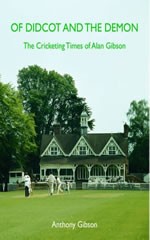Of Didcot And the Demon
Martin Chandler |Published: 2009
Pages: 320
Author: Gibson, Anthony
Publisher: Fairfield Books
Rating: 4.5 stars

Alan Gibson was a gifted intellectual with an engaging if flawed personality whose failure to utilise his enviable array of talents in the world of commerce was cricket’s gain. He was a fine writer on the game and, for a time, broadcaster but his life was, sadly, worn down by depression, drink and the inevitable domestic difficulties that that combination brought with it.
“Of Didcot and the Demon” is really three books in one. It begins with the story of Alan’s life up until 1967 when he became a regular cricket correspondent for The Times. Author Anthony Gibson, Alan’s son from his first marriage, sets the scene beautifully. He sets out both his father’s qualities and his failings objectively and concisely yet still with great affection.
In 1968 the format changes and there is then a chapter for each year up until 1986. The individual years begin with a seamless commentary which continues the biography and also contains a summary of how the English game took shape that year. That summary is, primarily, a setting and framework for the extracts from Alan’s work that make up the bulk of each chapter, but it also represents a potted history of the County game over the period which reminds the reader just what a time of upheaval it was for cricket in England.
In 1985 Alan had a breakdown, physical and mental, and while 1986 brought a comeback of sorts that was his last year with “The Thunderer”. The decline from then until his death in 1994 was a sad one and is recorded very briefly before the book closes with Alan’s last published piece from “The Cricketer”, a memoir of his former colleague John Arlott who died in 1991, and finally a poignant extract from “Growing up with Cricket”, a book of reminiscences that he published in 1985.
The main part of the book is, of course, Alan’s writings and the scene having been set by Anthony’s commentary what might otherwise have been a disjointed collection of writings becomes almost a story in itself. That story is told, in the main, through extracts from Alan’s match reports but there are also some excellent historical pieces and features as well as some book reviews which demonstrate very clearly the full range of Alan’s talents and leave the reader in no doubt as to his deep love for and knowledge of cricket.
The difference in style between Alan Gibson and his contemporaries was marked enough but with today’s writing there is no real room for comparison at all. In the 21st century cricket reporting is an exercise in analysis rather than the descriptive art form it was just a generation or so ago when Alan was at the peak of his powers. What sets him apart from his peers is the discursive elements to his writing which lead to many observations on extraneous matters, hence the reference in the title to Didcot railway station. The remaining half of the title, the Demon, is the shortened form of Alan’s soubriquet for Somerset seamer Colin Dredge, “The Demon of Frome”.
I could wax lyrical about Alan Gibson’s writing for several paragraphs yet but that would be no substitute for first hand experience and author and publisher have kindly agreed to allow CricketWeb to publish this extract from the book. There is no reference in it to Didcot station or “The Demon of Frome”, nor for that matter “The Shoreditch Sparrow” or “JJ”, or the ladies “Phyl” and “GRIP” – if you want to meet them you will have to go out and spend your hard earned on this magnificent book but the star of the extract, “The Old Bald Blighter”, is certainly my favourite Gibson character.






Leave a comment